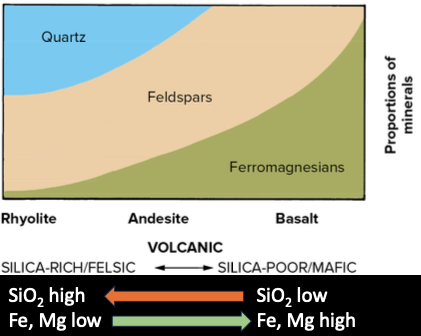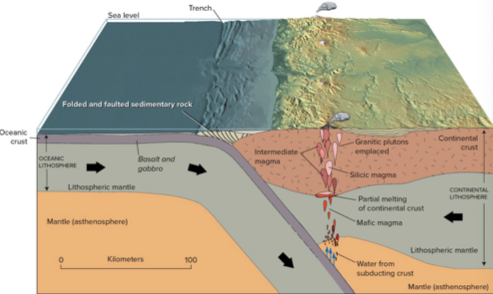Magma
Magma is the molten or semi-molten natural material from which all Igneous rocks are formed. Found beneath the surface of the Earth.
Magma Sources and Types
-
Recall: lava is magma (i.e., molten rock) that flows on the earth’s surface
-
Temperature should be high enough and pressure low enough to melt rock
- Most magma originates in upper mantle (50-250 km deep in Earth)
-
Most volcanoes found in one of these 3 settings:
- Divergent boundary – oceanic and continental
- Convergent boundary – above subduction zones
- Hot spots (i.e., not associated with plate boundary)
-
Magma composition and physical properties dictate how the volcano erupts
-
Composition determined by the rock material that is melted and extent of melting
-
Raw materials and melting processes controlled by the tectonic setting

Origin of Magma
-
Rocks in asthenosphere are close to melting point but needs • A reduction in pressure, like in a spreading ridge OR
-
Water to lower melting temp, like in a subducting plate that warms up and the water within rocks/minerals are released
-
Resulting magma is less dense and will begin to rise up through solid rock
-
Or can sit in a magma chamber where cooling and fractional crystallization will occur (i.e., higher temperature minerals start to crystallize and fall out)
Magma compositions vary in silica (SiO2), iron, magnesium, and gases
- Mafic magma – low in SiO2 (45-50 %) but high in iron and magnesium. Low viscosity, flow easily. Gas escapes easily.
- Magma in asthenosphere is ‘ultramafic’
- Intermediate magma – intermediate range of SiO2 (50-65 %), iron, and magnesium. Intermediate viscosity.
- Felsic magma – high in SiO2 (up to 75 %) with some aluminum, but low in iron and magnesium. High viscosity, flow slowly. Gases get trapped, cause explosions.
Tectonic setting partially drives magma decomposition and rocks formed at surface
- Spreading ridges ⇒ basalts
- Mafic because not restricted on way to surface
- Continental rift ⇒ basalts or rhyolites (felsic) or andesite (intermediate)
- Magma interacted with more material on its path to the surface
- Ocean hot spots ⇒ basalts
- Continental hot spots ⇒ andesite-rhyolites

- Magmatic activity in subduction zone is complex
- Mostly basaltic to andesitic (i.e., more mafic)
- But can mix with sediments while subducting plate or interact with overlying crust while traveling back to surface ⇒ more felsic

- But can mix with sediments while subducting plate or interact with overlying crust while traveling back to surface ⇒ more felsic